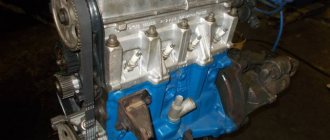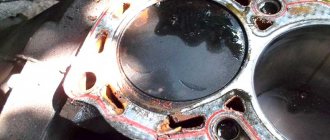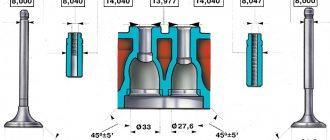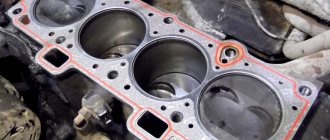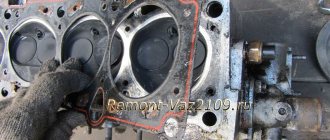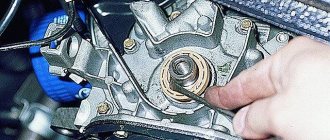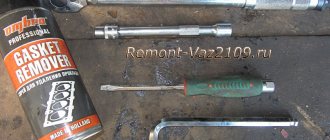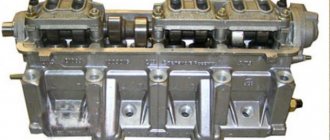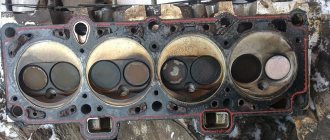How much does a VAZ 2104 engine weigh?
How much does a VAZ engine weigh?
| Model | Working volume, cm3 | Weight, kg |
| VAZ 2104 -1000260 | 1450 | 120 |
| VAZ 2106-1000260 | 1570 | 121 |
| VAZ 21083-1000260-53 | 1500 | 127,3 |
| VAZ 2111-100026080 | 1490 | 127,3 |
Technical features
Characteristics of the VAZ 2106 engine:
- The cylinder block is made of cast iron
- Can work with both carburetor and inverter type power systems
- The engine cylinders are in-line
- There are 4 cylinders in total
- There are 2 valves on the cylinder
- The distance from the lower to the upper position of the piston is 80 millimeters
- Each cylinder has a diameter of 79 millimeters
- The compression ratio of the unit is 8.5 atmospheres
- The power of the VAZ 2106 engine is 75 horsepower
- Engine displacement – 1,569
- You can use AI92 gasoline
- For every 100 kilometers on the highway, consumption averages 7.4 liters, and in the city - 10 liters
- For every 1000 kilometers, 700 grams of oil are consumed
- The following types of oil can be used: 5w-30, 5w-40, 10w-40, 15w-40
- When changing oil you need to use 3.5 liters
- According to factory data, the unit can travel up to 125,000 kilometers. In fact, it works up to 200,000 kilometers
- Installed on both VAZ 2106 and VAZ 21074, as well as VAZ 2121, VAZ 21053, VAZ 2103.
- Candles should be used of the following type: A17DVR, A17DV-10, FE65CPR
- The weight of the VAZ 2106 engine is 121 kilograms
How many kg of aluminum are in the VAZ 2106 engine?
How we are working
| VAZ model | Car weight | Blockage |
| 2105 | 955 kg | 30% |
| 2106 | 1045 kg | 30% |
| 2107 | 1060 kg | 30% |
| 2109 | 945 kg | 30% |
Interesting materials:
What is the difference between cabbage soup and green borscht? How to remove hair dye from a case? How to remove soap stains on glass? How to clean the outside of a stainless steel kettle? How to clean the floor from silicone? How to clean silicone from the toilet? How to remove sticker marks? How to clean the inside of a thermos from tea? How to remove iodine from clothes? How to remove red wine from white jeans?
Typical faults and features
If you know the features of the motor used in your personal car, you can significantly extend its service life and maintain good performance. Therefore, we will consider the most typical aspects that relate to this unit.
Warming up . In winter, the engine needs to be warmed up. You need to wait at least five minutes until the speed increases to 1500 rpm. Once the idle starts to hold up well, you can hit the road.
Oil . As for oil, problems often arise due to excessive savings. Owners of the “six” often buy low-quality oil or do not replace it in a timely manner. This leads to the fact that after a mileage of 60 thousand kilometers, the cylinders may increase in diameter. Also, sometimes situations arise that the engine begins to consume too much oil - more than 1 liter for every thousand kilometers. This indicates that it is time to measure the compression. This will let you know if there is a problem with the rings or valves.
What kind of motor can be installed on a “penny” instead of the standard one?
One of the main types of car tuning is improving the car engine. VAZ 2101 engines are an unplowed field in this sense. Some craftsmen install turbines on them in order to increase power and traction characteristics, others change the crankshaft and bore the cylinders, and still others simply change the engine to a more powerful one. But here it is important not to overdo it, because the car body is designed for certain loads, exceeding which can seriously harm the entire car.
Among the popular options for replacement, it is worth considering only power units that are similar in design and performance. For a penny, without any problems, you can install a 1.6 or 2.0 liter gasoline engine from the same Fiat Argenta or Polonaise.
The engine from Fiat Argenta can be installed on any classic VAZ without any special modifications
You can try the same engine from Renault Logan or Mitsubishi Galant, if you install them together with a gearbox. But the best option is a power unit from subsequent modifications of VAZs. These could be VAZ 2106, 2107, 2112 and even 2170. The engines from these cars are suitable both in size and in mounting to the gearbox.
Tuning
- The tuning option with an increase in volume involves boring the cylinders and replacing the pistons with spare parts from older VAZ engines. Such work is somewhat difficult and can be expensive. It is necessary to bore the cylinders, replace the pistons and crankshaft. It is often easier to carry out an engine swap by installing an engine from a VAZ five or six.
- Installing a turbine can be considered solely in theory, since this tuning option leads to rapid failure of the VAZ 2101, the engine tuning of which was performed using a turbine and compressor. An engine with an installed turbine has a service life of about 20 thousand kilometers, while the power indicator in rare cases exceeds the 100 horsepower mark. This option is used only for cars participating in drag racing, where car owners do not care about the life of the car, but only the technical characteristics of the forced engine are at the forefront.
Material of manufacture
With this configuration of the body and suspension, the frame material plays a significant role in the safety and stability of the car. It is logical that strengthening the weak points of the body will make the vehicle stiffer and more stable on the road. But then the mass of the car will be critical, which will make it clumsy and very heavy.
When strengthening the frame, the weight of the “penny” and the load on all structural elements increases. That is why design engineers are trying to select the rational thickness of materials, taking into account the ratio of their dimensions and cross-section. The result is a fairly durable and not too heavy body.
To reduce weight and save on costs, elements that do not bear the load are made of thinner metal. The main parts have a thickness of about one millimeter, which corresponds to similar indicators for other cars of similar class.
In this section we collect accumulated information on the parameters of serial and tuning parts - weight, volume, and other quantities. For parts, the manufacturer (optional) and other parameters are indicated. The weight of parts is measured with an accuracy of 1 gram. This information should be used for reference purposes only. We warn you that due to imperfect technological processes at factories, the weight and other parameters of parts in different batches may differ. For Oka, we remember about the unification with the 08 family (1111 = 2108, 11113 = 21083).
_______ Weight of parts (in grams)
| Pistons, fingers | |
| Piston 2110 (1st repair, d = 82.4 mm, group A), VAZ | 357 |
| Piston 21083 (nominal, d = 82.0 mm, group A), VAZ | 335 |
| Piston 2108 (nominal, d = 76.0 mm, group B), VAZ | 286 |
| Piston pin 21083, VAZ | 103 |
| Piston rings | |
| 82.00 “SM” 1 compression ring | 8 |
| 82.00 “SM” 2 compression ring | 11 |
| 82.00 “SM” oil scraper ring set (2 discs + spring) | 8 |
| Connecting rods | |
| Connecting rod 2108, VAZ | 671 |
| Connecting rod 2110, VAZ (for floating pin) | 680 |
| Valves 37x31 | |
| 21083 standard intake 37x8x104 mm “SZK” \ \ lightweight “T-shaped” \ lightweight “tulip” | 80 \ 57 \ 55 |
| 21083 issue standard 31x8x104 mm "VAZ" \ \ lightweight "T-shaped" \ lightweight "tulip" | 72 \ 52 \ 50 |
| 2101 “classic” standard intake 37x8x112.5 mm “SZK” \ \ lightweight “tulip” | 81 \ 57 |
| 2101 “classic” standard edition 31.5x8x113.5 mm “SZK” \ \ lightweight “tulip” | 71 \ 54 |
| Valves 39x34 | |
| “STK Sport” intake 39x8x104 mm \ lightweight at the end \ \ enlarged tulip | 67 \ 65 \ 60 |
| “STK Sport” edition 39x8x104 mm \ lightweight at the end \ \ enlarged tulip | 67 \ 61 \ 57 |
| Valves 42x35 | |
| BMW intake 42x8x104 mm \ lightweight | 85 \ 58 |
| BMW edition 35x8x104 mm \ lightweight | 79 \ 52 |
| Valves 40x35 stem 7 mm | |
| BMW intake 40x7x103 mm \ lightweight | 69 \ 52 |
| BMW edition 34x7x103 mm \ lightweight | 60 \ 46 |
| Valves 41x35 (rework 41x38) stem 7 mm, VAZ “Classic” | |
| (import) intake 41x7 mm \ lightweight | 91 \ coming soon |
| (import) release 38x7 mm \ 35x7 lightweight | 87 \ coming soon |
| Valves UZAM 1.7 40x34 stem 8 mm | |
| UZAM intake 40x8x117 mm \ lightweight | 82 \ 65 |
| UZAM release 34x8x112 mm \ lightweight | 69 \ 61 |
| Valves 2112 standard stem 7 mm | |
| 2112 intake \ lightweight | — \ 39 |
| 2112 issue \ lightweight | — \ 37 |
| Timing: Other | |
| 2108 Upper spring plate (modified by OKB along the cone) | 16 |
| 2108 Upper spring plate (modified along the planes) | 14 |
| 2108 Upper spring plate made of duralumin (made in Togliatti) | 9 |
| 2101 Upper spring plate (modified along the planes) | 20 |
| 2108 Valve pusher standard | 47 |
| 2108 Adjusting washer 4.00 mm | 24 |
| Adjustment post for solid pusher 5.55x8 mm | 2 |
| 2108 Solid valve pusher (Moscow) | 50 |
| _______ Duralumin spring plates compared with standard ones, grams | |
| Serial spring plate 2108, Oka (material - steel) | 16 |
| Duralumin spring plate 2108, Oka | 6 |
| Serial spring plate VAZ "Classic" (material - steel) | 21 |
| Duralumin spring plate VAZ "Classic" | 9 |
| Serial spring plate UZAM (material - steel) | 25 |
| Duralumin spring plate UZAM | 10 |
| Serial spring plate ZMZ 402 (material - steel) | 32 |
| Duralumin spring plate ZMZ 402 | 14 |
| Serial spring plate BMW M10 (material - steel) | 16 |
| Duralumin spring plate BMW M10 | 8 |
| _______ Volumes of samples (combustion chamber parts) in detail (cm3) | |
| Piston 2110 (1st repair, d = 82.4 mm, group A), VAZ | 12 |
| Piston 21083 (nominal, d = 82.0 mm, group A), VAZ | 12 |
| Piston 2108 (nominal, d = 76.0 mm, group B), VAZ | 6 |
| Combustion chamber in the cylinder head 2109i (standard - defective? SZh 10.4) | 22 |
| Combustion chamber in the cylinder head 2101 - VAZ classic | 31 |
| _______ Internal diameters of cylinder head seats and valve sizes (mm) | |
| Cylinder head 1111 (650 cc) intake seat \ after boring | 30 \ 31 |
| Cylinder head 1111 (650 cc) exhaust seat \ after boring | 27,5 \ 29 |
| Cylinder head 11113 (750 cc) intake seat \ after boring | |
| Cylinder head 11113 (750 cc) exhaust seat \ after boring | |
| Cylinder head 2101 (classic) intake seat \ after boring | 31,5 \ 31 |
| Cylinder head 2101 (classic) exhaust seat \ after boring | 27 \ 31 |
| Cylinder head 1111 (650 cc) standard valve plate size | 35x31 |
| Cylinder head 11113 (750 cc) standard valve plate size | 37x31 |
| Cylinder head 2101 (classic) standard size of valve plates | 37x31 |
| _______ Diameters of the channels in the cylinder head at the inlet from the manifold side (mm) | |
| Cylinder head 1111 (650 cc) intake port \ after boring | 27,5 \ 31 |
| Cylinder head 1111 (650 cc) exhaust port \ after boring | 27 \ 31 |
| Cylinder head 2101 (classic) intake port \ after boring | 29,5 \ |
| Cylinder head 2101 (classic) exhaust channel \ after boring | 26,5 \ |
Section created: January 22, 2007 Last updated: July 7, 2010 Author of the article, photo-video materials: © Quasar Prohibited without the written permission of the author: reprint of the article in whole or in part, reprint and use of photo-video materials, as well as their modification and editing for further publication on third-party sites.
Disadvantages and advantages
The 2106 engine has significant disadvantages:
- excess heat is transferred to the well of the piston bottom and fins by steel control plates inside the bosses;
- dynamic loads are reduced due to the displacement of the finger from the axis of symmetry to the right;
- When assembled into an engine, the pistons are mounted with markings in one direction, which increases labor costs and the human factor.
The internal combustion engine uses a cylinder head from model 2103, a starter 35.3708 and a G221 generator for an engine with a current of 42A. Oil consumption does not exceed 700 g/1000 km. The instruction manual states that it is recommended to add 200 ml less lubricant than the volume of the system as a whole. The markings for which oil to pour are given in the upper table.
